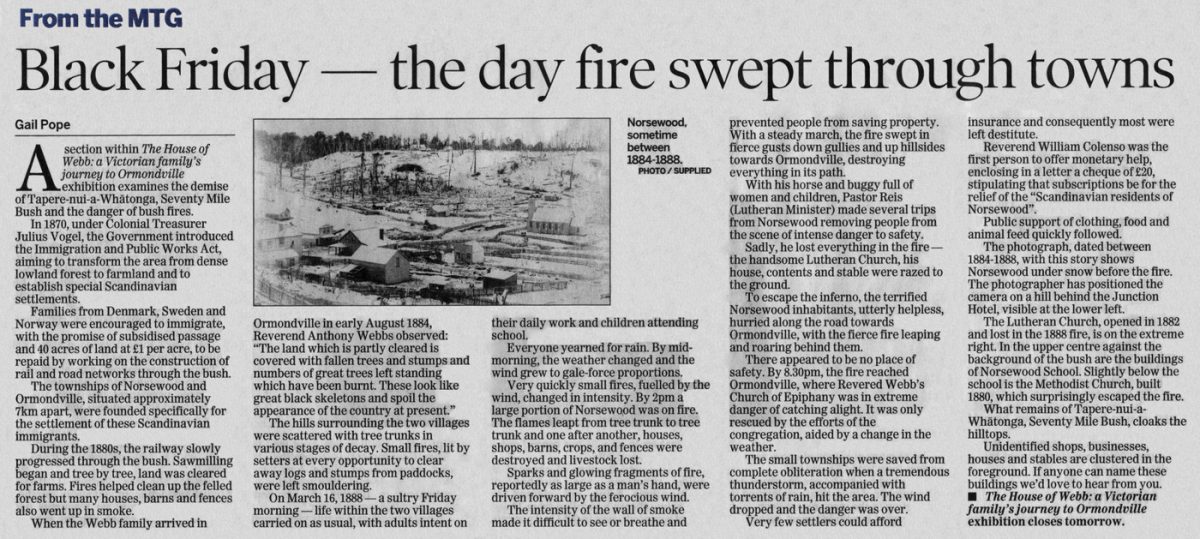From the MTG
Black Friday – the day fire swept through towns
Gail Pope
A section within The House of Webb: a Victorian family’s journey to Ormondville exhibition examines the demise of Tapere-nui-a-Whātonga, Seventy Mile Bush and the danger of bush fires.
In 1870, under Colonial Treasurer Julius Vogel, the Government introduced the Immigration and Public Works Act, aiming to transform the area from dense lowland forest to farmland and to establish special Scandinavian settlements.
Families from Denmark, Sweden and Norway were encouraged to immigrate, with the promise of subsidised passage and 40 acres of land at £1 per acre, to be repaid by working on the construction of rail and road networks through the bush.
The townships of Norsewood and Ormondville, situated approximately 7km apart, were founded specifically for the settlement of these Scandinavian immigrants.
During the 1880s, the railway slowly progressed through the bush. Sawmilling began and tree by tree, land was cleared for farms. Fires helped clean up the felled forest but many houses, barns and fences also went up in smoke.
When the Webb family arrived in Ormondville in early August 1884, Reverend Anthony Webbs [Webb] observed: “The land which is partly cleared is covered with fallen trees and stumps and numbers of great trees left standing which have been burnt. These look like great black skeletons and spoil the appearance of the country at present.”
The hills surrounding the two villages were scattered with tree trunks in various stages of decay. Small fires, lit by setters at every opportunity to clear away logs and stumps from paddocks, were left smouldering.
On March 16, 1888 – a sultry Friday morning – life within the two villages carried on as usual, with adults intent on their daily work and children attending school.
Everyone yearned for rain. By mid-morning, the weather changed and the wind grew to gale-force proportions.
Very quickly small fires, fuelled by the wind, changed in intensity. By 2pm a large portion of Norsewood was on fire. The flames leapt from tree trunk to tree trunk and one after another, houses, shops, barns, crops, and fences were destroyed and livestock lost.
Sparks and glowing fragments of fire, reportedly as large as a man’s hand, were driven forward by the ferocious wind.
The intensity of the wall of smoke made it difficult to see or breathe and prevented people from saving property. With a steady march, the fire swept in fierce gusts down gullies and up hillsides towards Ormondville, destroying everything in its path.
With his horse and buggy full of women and children, Pastor Reis [Ries] (Lutheran Minister) made several trips from Norsewood removing people from the scene of intense danger to safety.
Sadly, he lost everything in the fire – the handsome Lutheran Church, his house, contents and stable were razed to the ground.
To escape the inferno, the terrified Norsewood inhabitants, utterly helpless, hurried along the road towards Ormondville, with the fierce fire leaping and roaring behind them.
There appeared to be no place of safety. By 8.30pm, the fire reached Ormondville, where Revered [Reverend] Webb’s Church of Epiphany was in extreme danger of catching alight. It was only rescued by the efforts of the congregation, aided by a change in the weather.
The small townships were saved from complete obliteration when a tremendous thunderstorm, accompanied with torrents of rain, hit the area. The wind dropped and the danger was over.
Very few settlers could afford insurance and consequently most were left destitute.
Reverend William Colenso was the first person to offer monetary help, enclosing in a letter a cheque of £20, stipulating that subscriptions be for the relief of the “Scandinavian residents of Norsewood”.
Public support of clothing, food and animal feed quickly followed.
The photograph, dated between 1884-1888, with this story shows Norsewood under snow before the fire. The photographer has positioned the camera on a hill behind the Junction Hotel, visible at the lower left.
The Lutheran Church, opened in 1882 and lost in the 1888 fire, is on the extreme right. In the upper centre against the background of the bush are the buildings of Norsewood School. Slightly below the school is the Methodist Church, built 1880, which surprisingly escaped the fire.
What remains of Tapere-nui-a-Whātonga, Seventy Mile Bush, cloaks the hilltops.
Unidentified shops, businesses, houses and stables are clustered in the foreground. If anyone can name these buildings we’d love to hear from you.
The House of Webb: a Victorian family’s journey to Ormondville exhibition closes tomorrow.
Photo caption – Norsewood, sometime between 1884-1888. PHOTO/SUPPLIED












Do you know something about this record?
Please note we cannot verify the accuracy of any information posted by the community.